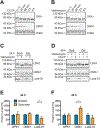Recent advances in, and challenges of, designing OMA1 drug screens
- PMID: 34999225
- PMCID: PMC8923697
- DOI: 10.1016/j.phrs.2022.106063
Recent advances in, and challenges of, designing OMA1 drug screens
Abstract
The proteases of the mitochondrial inner membrane are challenging yet highly desirable drug targets for complex, multifactorial diseases prevalent mainly in the elderly. Among them, OMA1 with its substrates OPA1 and DELE1 safeguards mitochondrial homeostasis at the intersection of energy metabolism and apoptosis, which may have relevance for neurodegeneration, malignancy and heart failure, among other diseases. Little is known about OMA1. Its structure has not been solved and we are just beginning to understand the enzyme's context-dependent regulation. OMA1 appears dormant under physiological conditions as judged by OPA1's processing pattern. The protease is rapidly activated, however, when cells experience stress or undergo apoptosis. Intriguingly, genetic OMA1 ablation can delay or even prevent apoptosis in animal models for diseases that can be broadly categorized as ischemia-reperfusion related disorders. Three groups have reported their efforts implementing OMA1 drug screens. This article reviews some of the technical challenges encountered in these assays and highlights what can be learned for future screening campaigns, and about the OMA1 protease more broadly. OMA1 does not exists in a vacuum and potent OMA1 inhibitors are needed to tease apart OMA1's intricate interactions with the other mitochondrial proteases and enzymes. Furthermore, OMA1 inhibitors hold the promise of becoming a new class of cytoprotective medicines for disorders influenced by dysfunctional mitochondria, such as heart failure or Alzheimer's Disease.
Keywords: AZD1080 (PubChem CID: 135564570); CCCP (PubChem CID: 2603); Cancer; Ceritinib (PubChem CID: 57379345); Drug discovery; MG132 (PubChem CID: 462382); Membrane proteases; Mitochondria; Neurodegeneration; Protease inhibitors; SB216763 (PubChem CID: 176158); Sorafenib (PubChem CID: 216239); Tamoxifen (PubChem CID: 2733526); Valinomycin (PubChem CID: 3000706).
Copyright © 2022 Elsevier Ltd. All rights reserved.
Conflict of interest statement
CONFLICT OF INTEREST
Dr. Marcel V. Alavi is shareholder of 712 North Inc., a California-based pharmaceutical company.
Figures



References
-
- Duvezin-Caubet S, Jagasia R, Wagener J, Hofmann S, Trifunovic A, Hansson A, Chomyn A, Bauer MF, Attardi G, Larsson NG, Neupert W, Reichert AS, Proteolytic processing of OPA1 links mitochondrial dysfunction to alterations in mitochondrial morphology, J Biol Chem 281 (2006) 37972–37979. - PubMed
-
- Kaser M, Kambacheld M, Kisters-Woike B, Langer T, Oma1, a novel membrane-bound metallopeptidase in mitochondria with activities overlapping with the m-AAA protease, J Biol Chem 278 (2003) 46414–46423. - PubMed
Publication types
MeSH terms
Substances
Grants and funding
LinkOut - more resources
Full Text Sources

